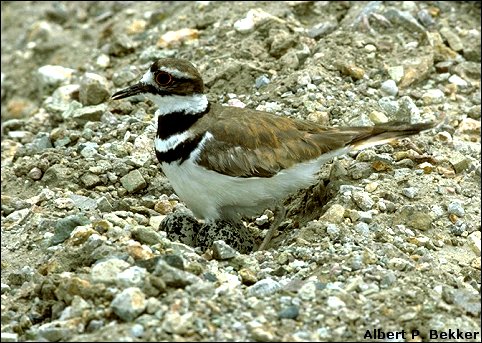
How can a bird's broken wing suddenly heal itself? Perhaps you have asked this question if you have come too close to a Killdeer's nest! This bird is often seen around desert wetlands and playas, and its plaintive call sounds remarkably like it is saying its own name: "Killdeer, killdeer".
The nest is well hidden, a few pebbles on the ground that blend in, as do the spotted eggs and babies. Mom and dad take no chances, though, when a predator comes too close. One of them fakes a broken wing. Flip-flopping helplessly on the ground, it moves away from the nest. No hungry predator can resist easy food and will follow the bird. Suddenly, now far enough away from the nest, the killdeer's "broken wing" is miraculously healed, and the bird flies to safety. This is, after all, a performance of life or death. If the bird is not convincing enough, its young could eaten. Perhaps these birds deserve an Oscar for such an outstanding performance!

Listen to the Audio (mp3 format) as recorded by KTEP, Public Radio for the Southwest.
Contributor: Scott M. Cutler, Centennial Museum, University of Texas at El Paso.
Desert Diary is a joint production of the Centennial Museum and KTEP National Public Radio at the University of Texas at El Paso.

Killdeer on its nest. Note the two well-camouflaged eggs under its breast. Photograph by Albert P. Bekker. © California Academy of Sciences, 1999.
Ligon, J. S. 1961. New Mexico Birds and Where to Find Them. University of New Mexico Press, Albuquerque, 360 pp.